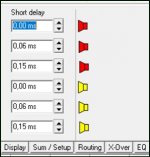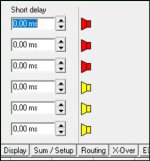Any thoughts aside from the usual caveats about using blind testing?
Very nice to see real human testing. Way to go!
All these elaborate mathematical truths are premised on one basic premise: you have only one ear and it never moves from its ideal location. Which is why the broad ambient stimulation provided by dipoles are so much in vogue right now. The fact that your group of people have any consensus suggests the model can't be right because the changes seem to affect everybody in different locations.
After lots of testing with your DSP (like all the rest of us folks with DSPs to fool with too), you tilted the speaker. Tilting the speaker - now there's something that can have a dramatic effect on sound quality in a number of ways. From what you say about listening to recordings after, betcha you changed the the treble at your chair. Might have been up or down, but good chance it changed and you liked it better.
Of course, when you think you've made an improvement and then start listening carefully to recordings more carefully afterwards...... (I've even started to enjoy hearing Bach played on pianos when I listen to Glenn Gould carefully).
B.
Very nice to see real human testing. Way to go!
All these elaborate mathematical truths are premised on one basic premise: you have only one ear and it never moves from its ideal location. Which is why the broad ambient stimulation provided by dipoles are so much in vogue right now. The fact that your group of people have any consensus suggests the model can't be right because the changes seem to affect everybody in different locations.
After lots of testing with your DSP (like all the rest of us folks with DSPs to fool with too), you tilted the speaker. Tilting the speaker - now there's something that can have a dramatic effect on sound quality in a number of ways. From what you say about listening to recordings after, betcha you changed the the treble at your chair. Might have been up or down, but good chance it changed and you liked it better.
Of course, when you think you've made an improvement and then start listening carefully to recordings more carefully afterwards...... (I've even started to enjoy hearing Bach played on pianos when I listen to Glenn Gould carefully).
B.
Last edited:
In which frequency range is the floor bounce reduced?
There is a rather thick carpet between the speakers and the listening position.
Increased ceiling bounce (since concrete)?
There is a rather thick carpet between the speakers and the listening position.
Increased ceiling bounce (since concrete)?
Last edited:
To bentoronto:
The testing was kind of semi-blind. I asked my friends to select which of the three settings they preferred using the Hypex remote without any information about the differences. They all picked the same setting.
The treble level was as close to identical before and after the tilting with the "tweeter axis" going from slighly below the ear level to slightly above.
You are correct that placebo in many cases is strong, especially when it comes to HiFi, and I can't confirm the effect with measurements. Still the percieved improvement is significant.
The testing was kind of semi-blind. I asked my friends to select which of the three settings they preferred using the Hypex remote without any information about the differences. They all picked the same setting.
The treble level was as close to identical before and after the tilting with the "tweeter axis" going from slighly below the ear level to slightly above.
You are correct that placebo in many cases is strong, especially when it comes to HiFi, and I can't confirm the effect with measurements. Still the percieved improvement is significant.
Updated report from the field:
A listening session with some friends ended up in that everyone, including myself, preferred the "frequency aligned" approach compared to the "delay aligned" approach even with the clearly audible frequencey response drawback.
Did you test freq aligned with and without group delay? I did a test to remove the group delay and it affected the unity of the drivers negative (4cm). 3way system.
Viper user, i don't know what you were actually doing....so pardon me if i'm missing your test.........but group delay and distance are not things that interchange....iow, you can't fix one by altering the other.
Did you test freq aligned with and without group delay? I did a test to remove the group delay and it affected the unity of the drivers negative (4cm). 3way system.
Interested to see some graphs or even downloadable file
manninen, its just an automatic setup with a mic and the filter then sets the delay and the polarity. The sound is like an 1sec 8bit noise impulse from each driver set.
Delay comes in different forms, shapes and sizes.group delay and distance
Delay comes in different forms, shapes and sizes.
Yes, of course.
How dare me me forget delay is voodoo hoodo magic 🙄
Couldn't possibly be either constant time (delay), or frequency dependent phase rotation expressed as time (group delay), could it ? 🙄🙄
Now I remember what you said about this last time.
Let me pick you up on the phase rotation, it only rotates on the chart, but really it keeps extending.
Let me pick you up on the phase rotation, it only rotates on the chart, but really it keeps extending.
manninen, its just an automatic setup with a mic and the filter then sets the delay and the polarity. The sound is like an 1sec 8bit noise impulse from each driver set.
Doesn't say much to me, how is step and phase responses compared to standard wrapping LR4?
manninen, to be fair, FIR is needed to get rid of the slow drifting of phase over the whole spectra. The impulse alignment only correct the joint.
Now I remember what you said about this last time.
Let me pick you up on the phase rotation, it only rotates on the chart, but really it keeps extending.
I can't follow what you are saying.
How about posting the chart you mention, and describe what you mean...
Did you test freq aligned with and without group delay? I did a test to remove the group delay and it affected the unity of the drivers negative (4cm). 3way system.
The method I have used so far is to first do a distance only based delay (see post #5) and then do a phase alignment by adjusting the crossover frequencies to different values on LF an HF side.
Sorry, but I don't have the equipment to do a 0-90 deg. measurement to study the phase alignment between elements.
For this you need an acoustically dead room which is very expensive, or at least do outdoor measurements which also takes a lot of time and effort.
I will have to trust my ears, which will be the final destination of the sound anyway 🙂
More experiments are made, and I will get back with the results and conclusions "soon".
For this you need an acoustically dead room which is very expensive, or at least do outdoor measurements which also takes a lot of time and effort.
I will have to trust my ears, which will be the final destination of the sound anyway 🙂
More experiments are made, and I will get back with the results and conclusions "soon".
No biggies, everybody hobbies hi-fi way they want.
I can measure quite good down to 400hz on my 3.8Mx5.8M room
Hobbying with umik is restricting cause you can´t get measurements to simulation software so you allways have to measure whole speaker at once.
0-90deg ain´t that bad, i used tape marks on the floor and plumb line from mic stand.
Using REW is ok, just need to know how to understand IR window lengths
Im just luring you deeper into this madness
I can measure quite good down to 400hz on my 3.8Mx5.8M room
Hobbying with umik is restricting cause you can´t get measurements to simulation software so you allways have to measure whole speaker at once.
0-90deg ain´t that bad, i used tape marks on the floor and plumb line from mic stand.
Using REW is ok, just need to know how to understand IR window lengths
Im just luring you deeper into this madness
I trust my ears more than my (missing) skill with the Umik-1.
Until now, I have used the umik mainly for two things:
1) Measuring the insides of the boxes by putting the mic close to the woofer and mid elements, mainly to fight standing waves on the inside (with Helmholz resonators).
2) Measuring the room modes, below 200Hz, to cut these frequencies down in the DSP.
For both these purposes, the umik has been essential, and I would not have got this far without it.
My room is so far from perfect that I don't really trust the in-room measurements from the whole speaker. Here my ears have helped me more than the umik.
I guess the next step will be to learn more about IR windows in REW if I want to improve my skills.
Until now, I have used the umik mainly for two things:
1) Measuring the insides of the boxes by putting the mic close to the woofer and mid elements, mainly to fight standing waves on the inside (with Helmholz resonators).
2) Measuring the room modes, below 200Hz, to cut these frequencies down in the DSP.
For both these purposes, the umik has been essential, and I would not have got this far without it.
My room is so far from perfect that I don't really trust the in-room measurements from the whole speaker. Here my ears have helped me more than the umik.
I guess the next step will be to learn more about IR windows in REW if I want to improve my skills.
Last edited:
- Home
- Loudspeakers
- Multi-Way
- Active LR4 crossover phase matching using a DSP

